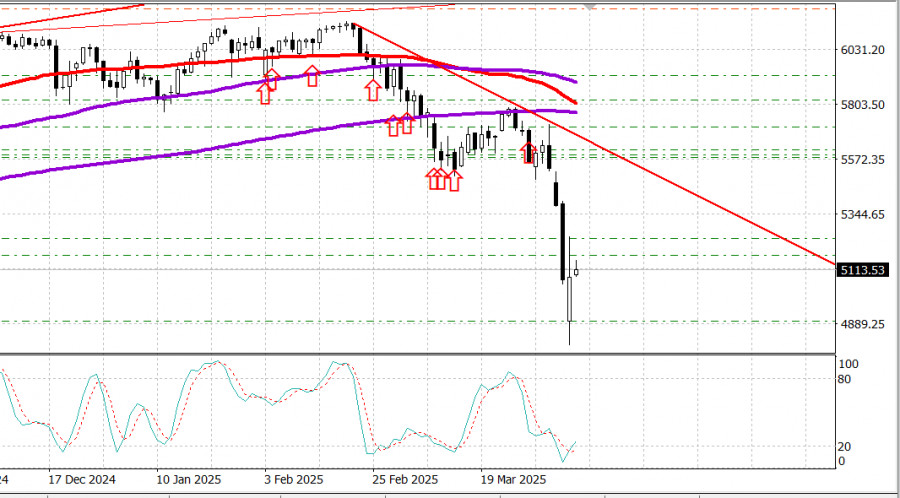See also


 08.04.2025 01:04 PM
08.04.2025 01:04 PMS&P 500
Overview for April 8
US market sees sharp rebound. Part 2
Major US indices on Monday: Dow -0.9%, NASDAQ +0.1%, S&P 500 -0.2%, S&P 500: 5,062, trading range: 4,800–5,700.
The stock market exhibited extreme turbulence in the first session of the week, with volumes above average.
The S&P 500 (-0.2%), which had been trading in bear market territory (20% below its recent high) near its session lows, fluctuated more than 400 points between its intraday high and low. The index dropped 4.7% shortly after the opening bell and rallied 3.4% at its peak.
The Nasdaq Composite, which had fallen more than 800 points at its lowest, managed to close 0.1% higher thanks to a rebound in megacap stocks and chipmakers.
The initial bounce from session lows coincided with a mistaken report that NEC Director Kevin Hassett said US President Donald Trump was considering a 90-day pause on tariffs, excluding China.
The White House later called the report fake news and stated that the United States would impose an additional 50% tariff on Chinese imports starting Wednesday if China does not remove its 34% tariff on US goods.
In response, selling resumed, though major indices remained significantly above their worst levels of the session. One of the key factors holding equity indices above their session lows was a reversal in the Treasury market.
Recently, market yields had been falling amid a flight to safety, but on the day, the 10-year yield surged 17 basis points to 4.16%, while the 2-year yield climbed six basis points to 3.73%.
Year-to-date performance:
Dow Jones Industrial Average: -10.8%S&P 500: -13.9%S&P Midcap 400: -16.1%Russell 2000: -18.8%Nasdaq Composite: -19.2%
Today's macroeconomic data was limited to consumer credit, which fell by $0.8 billion in February (consensus: +$15.1 billion) after an upwardly revised increase of $8.9 billion in January (previously reported as $18.1 billion).
The key takeaway from the report is that February marked the third decline in consumer credit over the past four months.
Energy: Brent crude at $64.90.
Oil rebounded slightly after a sharp sell-off that mirrored declines across US and global equity markets, with prices approaching $65. This is roughly $10 lower than levels seen before Trump's tariff wars began. Oil remains under pressure amid expectations of a broader slowdown in the global economy and weakening global demand for crude as a result of the trade conflict, primarily between the US and China.
Conclusion:
The picture of the trade war initiated by Trump on April 2 is gradually becoming clearer. The main "frontline" of this trade war is the United States versus China. The second key player, the EU, has either implemented only modest countermeasures or is attempting to negotiate. Japan is actively engaging in talks with Trump. Moreover, both the EU and Japan received noticeably lower tariffs from the US, while China has already been hit with 34% and 20% tariffs – a combined 54% – with an additional 50% hike threatened as of April 8, unless it cancels its own 34% retaliatory tariffs on US goods. China has already refused.
Both sides are showing no signs of backing down. At a potential 100% tariff level, a complete breakdown in US-China trade relations appears possible – an end to a deep commercial partnership that has been in place since the Nixon–Kissinger era in 1978. Cautious analysts are now even raising concerns over a sharp escalation of military tension from China around Taiwan as a logical consequence of the US-China trade war. If such a conflict materializes, there is a genuine risk of direct US-China military confrontation with global implications.
US market outlook: It is recommended to keep holding long positions from recent lows and dips. There is a chance of a new upward wave in the US market despite ongoing trade war concerns. Strong pullbacks may offer fresh buying opportunities.
You have already liked this post today
*The market analysis posted here is meant to increase your awareness, but not to give instructions to make a trade.
Training video

Your IP address shows that you are currently located in the USA. If you are a resident of the United States, you are prohibited from using the services of InstaFintech Group including online trading, online transfers, deposit/withdrawal of funds, etc.
If you think you are seeing this message by mistake and your location is not the US, kindly proceed to the website. Otherwise, you must leave the website in order to comply with government restrictions.
Why does your IP address show your location as the USA?
Please confirm whether you are a US resident or not by clicking the relevant button below. If you choose the wrong option, being a US resident, you will not be able to open an account with InstaTrade anyway.
We are sorry for any inconvenience caused by this message.

